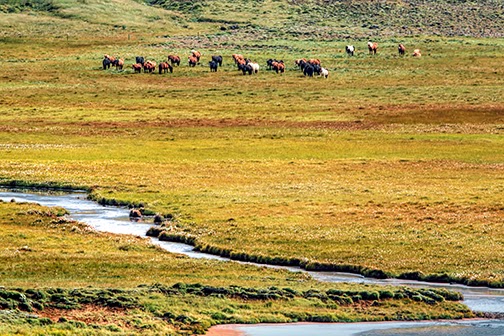
 Next to Grindavik there is a geothermal area called Krysuvik.
Next to Grindavik there is a geothermal area called Krysuvik. It consists of several colorful fields of yellow, green and red mineral deposits formed by the chemical reactions between the sulfuric gases and the rocks.
One of those fields is the area named SELTUN.

Just before turning left to Seltun we came upon a lake of unearthly turquoise waters. It looked like the weather has finally decided to to give us a break.
It was still rainy and wet but the peeking sun prepared an amazing scene for us and our vehicle screeched in pain as we forced it to make an abrupt stop.
Those who love to take photos know that a rainbow might not last long enough!
And, it did not.
The lake is actually a crater of an old volcano and its waters are colored with dissolved minerals and microscopic organisms common in the volcanic areas. The last time we saw something similar was in Yellowstone N.P. though that was on a smaller scale.
This is Graenavatn - the Green Lake (vatn = lake)
This is Graenavatn - the Green Lake (vatn = lake)
 Like Genie in a bottle - the steam vent is waiting for its moment.
Like Genie in a bottle - the steam vent is waiting for its moment. There had been an earlier attempt here to gather some of the energy but it ended up in a destruction of the equipment.
Seltun is relatively a small area but it happily exhibits an array of stinky solfataras, hot fumaroles and steaming hot springs all along with mudpots and their heavy bloop-blooping skin-scolding mud bubbles.
 This acidic water is capable of
dissolving metals present in sulfide ores, which results in brightly
colored, toxic streams.
This acidic water is capable of
dissolving metals present in sulfide ores, which results in brightly
colored, toxic streams.  There were sulfur mines here in the 18th an 19th centuries - with the product exported many countries of the world. Sulfur from here had been used in the manufacture of gunpowder.
There were sulfur mines here in the 18th an 19th centuries - with the product exported many countries of the world. Sulfur from here had been used in the manufacture of gunpowder.
There is much more to be explored around Krysuvik - we are turning back and inland to see what we can find about the largest lake on Reykjanes - Kleifarvatn (vatn = lake)
The idyllic meadow scenes won't last - we are heading straight for another set of vast lava fields.
The tiny white dots in the grass are the soft heads of arctic cotton weed.
And, knowing where the water came from, I would advise the horses to abstain!












No comments:
Post a Comment